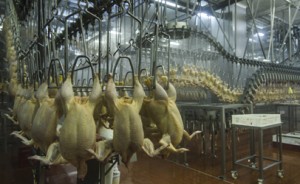I recently came across an interesting article about Salmonella poisoning in The United States which explained that although Salmonella is a leading cause of foodborne illness, the American authorities have a very tolerant approach towards food manufacturers regarding Salmonella. Whereas The US government takes E-Coli bacteria more seriously, they allow food with a 10 per cent rate of Salmonella contamination to be sold to consumers, this even though it is the leading cause of foodborne illness globally.
1.4 Million people become sick from Salmonella poisoning each year in the USA alone, with chicken being the leading cause of contamination.
The American CDC reported that 124 people in 12 states became ill with Salmonella and over 30 were hospitalized after being exposed to Foster Farms chicken between June of last year and this year January.
Read more about the situation below with an article from FoodSafetyNews.com:
Lynne Terry of the Oregonian touched on the issue of Salmonella as or as not an adulterant in her story yesterday–“Foster Farms chicken linked to Salmonella cases in Oregon and Washington, health officials say”:
The U.S. Department of Agriculture regulates poultry manufacturers and tests samples harmful bacteria. But it does not have a zero tolerance policy for Salmonella, unlike E. coli O157:H7, which is one of the deadliest food borne pathogens. Instead, the agency allows manufacturers to distribute raw poultry provided samples don’t turn up more than a 10 percent rate of Salmonella contamination.
But there is a caveat: Food manufacturers are not allowed to make people sick.
“Salmonella in chicken is legal except when you have an outbreak,” said Emilio DeBess, state public health veterinarian.
The U.S. Department of Agriculture’s Food Safety and Inspection Service (FSIS) “Performance standard” (an odd term) for Salmonella contamination in young chickens is 7.5 percent, and the reality is that the contamination rate you will find in the store is likely even higher.
Raw chicken and poultry especially can carry bacteria, particularly salmonella bacteria, which is responsible for more cases of food poisoning than any other pathogen in the world. The good news is that it is easily avoidable with the proper food handling practices.
While most people and consumers are well aware of the potential for chicken to cause Salmonella poisoning, a lot of people don’t take the risks seriously enough. Salmonella in chicken is more common than most people think and so should be handled with extreme care.
Salmonella poisoning can be extremely dangerous. Who can forget the incident of the young girl in Sydney, whose father sued KFC after she suffered brain damage from a Salmonella infection contracted after eating chicken from the fast food outlet? The girl’s quality of life has been forever altered due to the Salmonella contamination. This incident was an example of why properly cooking chicken should be an important action for anyone preparing chicken. Salmonella bacteria are extremely tricky because it doesn’t alter the smell or taste of the chicken even if it is contaminated.



 Lynne Terry of the Oregonian touched on the issue of Salmonella as or as not an adulterant in her story yesterday–“Foster Farms chicken linked to Salmonella cases in Oregon and Washington, health officials say”:
Lynne Terry of the Oregonian touched on the issue of Salmonella as or as not an adulterant in her story yesterday–“Foster Farms chicken linked to Salmonella cases in Oregon and Washington, health officials say”:
